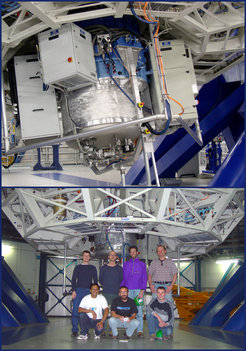Frank Eisenhauer receives Tycho Brahe Medal
The European Astronomical Society (EAS) awards the 2021 Tycho Brahe Medal to Dr Frank Eisenhauer (Max Planck Institute for Extraterrestrial Physics, MPE) for his leadership of the SINFONI and GRAVITY instruments on the ESO VLT, which revolutionized the study of exoplanets, supermassive black holes, and star forming galaxies in the early universe. Both SINFONI and GRAVITY are part of the instrument suite employed in the discovery and characterization of the Galactic Center Black Hole, which led to the Nobel Prize 2020 in Physics.

The SINFONI instrument attached to one of the four VLT telescopes after completion in 2004 (top). Frank Eisenhauer (standing second from right) and the instrument team in front of the SPIFFI/SINFONI instrument in 2003.
Over the last 20 years, Frank Eisenhauer and the MPE team developed two major, game-changing instruments for ground-based infrared astronomy, SINFONI and GRAVITY.
SINFONI revolutionized the spectroscopy of stars close to the Galactic Center black hole and the kinematic studies of galaxies at the peak of galaxy formation a few billion years after the Big Bang. It consists of an integral field spectrometer coupled to an adaptive optics system. Integral filed spectroscopy is a technique to simultaneously record an image and the spectrum for every pixel of the image, and adaptive optics corrects the blurring due to the Earth’s atmosphere. The development of SINFONI catapulted integral-field units to the leading design choice of imaging spectroscopy for all large telescopes, including also the ESO-ELT, a 40m-class telescope currently under construction.
The next major technological breakthrough came with GRAVITY, which combines the light of all four VLT telescopes interferometrically. This allows astronomers to use the four telescopes simultaneously as a virtual 130m telescope achieving milli-arcsecond resolution – sharp enough to detect houses on the moon, if there were any.

After a mere three years of science operation, GRAVITY has already provided several breakthroughs: Combining GRAVITY astrometry and SINFONI spectroscopy, the team was able to measure the gravitational redshift and relativistic precession in the orbit of the star S2 around the Galactic Center black hole SgrA*. The astronomers also used GRAVITY to observe gas swirl at around 30% the speed of light close to the innermost stable orbit around SgrA*. This provides very strong support that SgrA* indeed is a massive black hole. GRAVITY can also look outside our home galaxy: in the quasar 3C273, at a distance of ca. 1.4 billion light years, the instrument directly measured the rotation of the Broad Line Region, a set of clouds rotating around the black hole in the center of this galaxy. Further, GRAVITY can zoom onto exoplanets around nearby stars, and for example, could reveal the details of an exoplanet's atmosphere in the constellation of Pegasus.

This collage shows some of the results obtained with GRAVITY in its first three years of observation showing the wide range of possible applications.
With the Tycho Brahe Medal, which is awarded in recognition of the development or exploitation of European instruments or major discoveries based largely on such instruments, the EAS recognizes that Frank Eisenhauer was the leader and driver in the design and development of these complex and innovative instruments and has been a key figure in their scientific exploitation. Frank Eisenhauer studied physics at the Technical University of Munich (TUM) and obtained his PhD in 1998 from the Ludwig Maximilian University Munich. He is currently a Senior Research Scientist at MPE and Adjunct Teaching Professor at TUM. From 1998-2004 Dr Eisenhauer was leading the development on the world’s first adaptive optics assisted integral field spectrometer on an 8m-class telescope, SINFONI. He then became the leader of the GRAVITY instrument to combine the light from the four 8m VLT telescopes, which is operated at the VLT since 2016. The instrument is currently further developed into GRAVITY+, enhancing its capabilities and sensitivity. The Ieader of this project is again Dr Eisenhauer.














